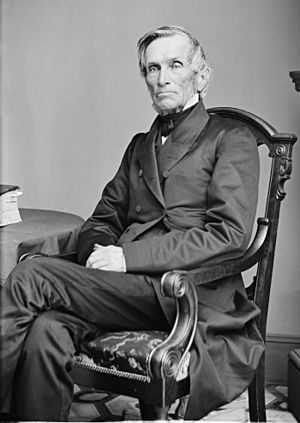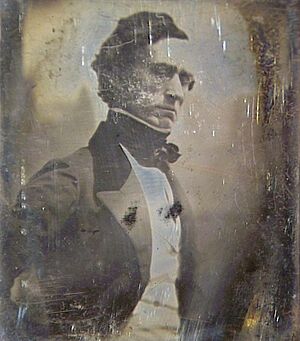Theodore Frelinghuysen facts for kids
Quick facts for kids
Theodore Frelinghuysen
|
|
|---|---|
 |
|
| 7th President of Rutgers University | |
| In office 1850–1862 |
|
| Preceded by | Abraham Bruyn Hasbrouck |
| Succeeded by | William Campbell |
| 2nd Chancellor of New York University | |
| In office 1839–1850 |
|
| Preceded by | James M. Mathews |
| Succeeded by | Isaac Ferris |
| 2nd Mayor of Newark | |
| In office November 10, 1837 – November 10, 1838 |
|
| Preceded by | William Halsey |
| Succeeded by | James Miller |
| United States Senator from New Jersey |
|
| In office March 4, 1829 – March 3, 1835 |
|
| Preceded by | Mahlon Dickerson |
| Succeeded by | Garret D. Wall |
| 12th Attorney General of New Jersey | |
| In office February 6, 1817 – March 4, 1829 |
|
| Governor | Isaac Halstead Williamson |
| Preceded by | Aaron Woodruff |
| Succeeded by | Samuel L. Southard |
| Personal details | |
| Born | March 28, 1787 Franklin Township, New Jersey, U.S. |
| Died | April 12, 1862 (aged 75) New Brunswick, New Jersey, U.S. |
| Political party | Democratic-Republican (Before 1829) National Republican (1829–1834) Whig (1834–1854) |
| Spouses |
Charlotte Mercer
(m. 1809, died)Harriet Pumpelly
(m. 1857–1862) |
| Relatives | Frederick Frelinghuysen (Father) |
| Education | Princeton University (BA) |
| Signature | |
Theodore Frelinghuysen (March 28, 1787 – April 12, 1862) was an American politician from New Jersey. He served as a United States Senator and was a candidate for Vice President of the United States. In the 1844 United States presidential election, he ran with Henry Clay as the Whig vice presidential nominee.
Frelinghuysen was born in Somerset County, New Jersey. He became a lawyer in Newark, New Jersey after graduating from the College of New Jersey. His father, Frederick Frelinghuysen, was also a Senator. Theodore later adopted his nephew, Frederick T. Frelinghuysen, who became a United States Secretary of State.
He held several important roles, including New Jersey Attorney General from 1817 to 1829. He was a U.S. Senator from 1829 to 1835. As a Senator, he strongly disagreed with President Andrew Jackson's policy of Indian removal. After his time in the Senate, he was the Mayor of Newark from 1837 to 1838.
In 1844, Frelinghuysen was chosen as Henry Clay's running mate for president. However, they lost the election to James K. Polk and George M. Dallas. Frelinghuysen also led two universities: he was President of New York University from 1839 to 1850, and President of Rutgers College from 1850 to 1862. Frelinghuysen Township, New Jersey was named after him in 1848.
Contents
Early Life and Education
Theodore Frelinghuysen was born in 1787 in Franklin Township, Somerset County, New Jersey. His father was Frederick Frelinghuysen (1753–1804). Theodore's great-grandfather, Theodorus Jacobus Frelinghuysen, was an important minister. He helped found Queen's College, which is now Rutgers University.

Theodore Frelinghuysen married Charlotte Mercer in 1809, but she passed away that same year. They did not have children together. Later, when his brother Frederick died, Theodore adopted his nephew, Frederick T. Frelinghuysen (1817–1885). This adopted son later became the United States Secretary of State. Theodore Frelinghuysen married again in 1857 to Harriet Pumpelly.
He graduated from the College of New Jersey (now Princeton University) in 1804. He then studied law and became a lawyer in Newark, New Jersey in 1808. During the War of 1812, he served as a captain in a volunteer company.
Political Career Highlights
Frelinghuysen became the New Jersey Attorney General in 1817. This role meant he was the chief legal advisor for the state. He served in this position until 1829.
Serving in the U.S. Senate
In 1829, he became a U.S. Senator for New Jersey. He served in the Senate until 1835. During his time there, he became known for strongly opposing President Andrew Jackson's Indian Removal Act of 1830. This act aimed to move Native American tribes from their lands.
Frelinghuysen gave a long speech against the act, lasting three days. He warned about the serious problems that could come from forcing Native Americans off their land. Even though he spoke out, the Indian Removal Act was passed.
Mayor of Newark and Vice Presidential Run
After leaving the Senate, Frelinghuysen served as the Mayor of Newark, New Jersey from 1837 to 1838.
In 1844, he was chosen as the Whig candidate for vice president. He ran alongside presidential candidate Henry Clay. Some people thought Frelinghuysen's strong moral character would help balance Clay's reputation. However, their ticket lost the 1844 United States presidential election.
Leadership in Education and Societies
Beyond politics, Frelinghuysen held important leadership roles in education and other organizations. He was the second President of New York University from 1839 to 1850. He then became the seventh President of Rutgers College from 1850 until his death in 1862.
He also led several religious and social organizations. These included the American Bible Society and the American Tract Society. He was also involved with the American Colonization Society (ACS). This group supported sending free African Americans to Africa. Frelinghuysen was known as the "Christian Statesman" because of his strong religious beliefs and public service.
Death
Theodore Frelinghuysen passed away in New Brunswick, New Jersey on April 12, 1862. He was buried there at the First Reformed Church Cemetery.


